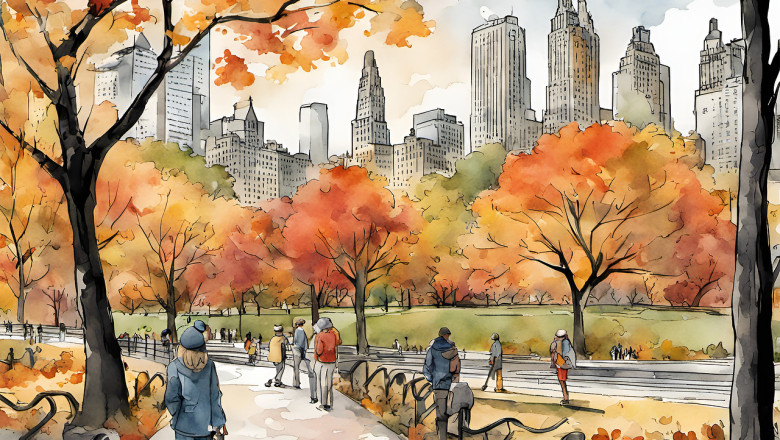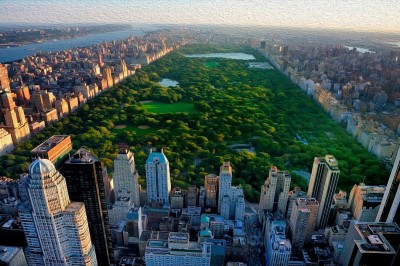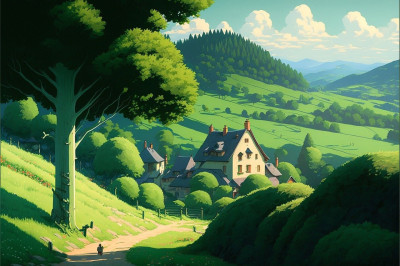The Pulse of New York City
New York City, often referred to as the Big Apple, is an epicenter of arts, culture, and history. This bustling metropolis is home to over 8 million people and serves as a beacon of diversity and innovation. The city's vibrancy is palpable, with its constant hum of activity and the ever-present promise of opportunity. From the iconic skyline dominated by towering skyscrapers to the verdant oasis of Central Park, New York City offers a dynamic environment that is both inspiring and exhilarating.
A Melting Pot of Culture
The cultural tapestry of New York City is one of its most defining characteristics. It is a place where a myriad of ethnicities, languages, and traditions coalesce, creating a rich mosaic that is celebrated through food, music, art, and festivals. Neighborhoods like Chinatown, Little Italy, and Harlem are just a few examples of the city's cultural enclaves, each with its own unique flavor and history. The city's commitment to cultural expression is evident in its numerous museums, galleries, and performance venues that showcase everything from avant-garde art to classical performances.
The City That Never Sleeps
New York City's reputation as "The City That Never Sleeps" is well-earned. Day and night, the city pulses with energy. Streets are lined with everything from world-renowned restaurants to hole-in-the-wall eateries, all offering a taste of the city's gastronomic diversity. The nightlife in New York is second to none, with an array of bars, clubs, and lounges that cater to every imaginable preference. Whether it's catching a Broadway show, enjoying a rooftop cocktail, or exploring the vibrant street life, there's always something to do in New York City.
An Architectural Wonderland
The architecture of New York City is as diverse as its population. The city's skyline is a testament to the ingenuity of human design, featuring landmarks such as the Empire State Building, the Chrysler Building, and the One World Trade Center. Beyond these towering structures, the city is also home to historic neighborhoods with brownstones, tenements, and the occasional cobblestone street that offer a glimpse into the city's storied past. The juxtaposition of old and new creates a visual symphony that is uniquely New York.
A Hub of Innovation and Commerce
New York City is a global hub of commerce, finance, and innovation. Wall Street's financial district is synonymous with global markets and economic trends, while Silicon Alley in Manhattan and the Brooklyn Tech Triangle are at the forefront of technological innovation and start-up culture. The city's ability to attract talent and investment has made it a breeding ground for new ideas and business ventures, further contributing to its dynamic atmosphere.
Green Spaces Amidst the Concrete Jungle
In the midst of the urban sprawl, New York City offers a surprising amount of green space where residents and visitors can find respite from the fast-paced city life. Central Park, the most famous urban park in the world, provides a sanctuary with its meadows, lakes, and walking paths. The High Line, an elevated park built on a historic freight rail line, offers a unique perspective of the city and a modern take on urban renewal. These green spaces are essential to the city's vibrancy, offering a place for relaxation, recreation, and community gatherings.
The Heartbeat of the Arts
New York City is a global center for the arts, home to world-class institutions like the Metropolitan Museum of Art, the Museum of Modern Art (MoMA), and the Guggenheim. The city's theater district, Broadway, is synonymous with top-tier live entertainment, drawing millions of visitors each year. The city also nurtures a thriving independent arts scene, with countless galleries, performance spaces, and arts festivals that celebrate the work of emerging artists and performers.
A Sports Fan's Paradise
For sports enthusiasts, New York City is a paradise with its storied sports teams and state-of-the-art venues. From the Yankees and Mets in baseball to the Knicks and Nets in basketball, the city's teams are a source of local pride and rivalry. The U.S. Open tennis tournament in Queens and the New York City Marathon are just two of the high-profile sporting events that draw fans from around the world.
New York City's vibrancy is a product of its diversity, its ceaseless activity, and its role as a cultural and economic powerhouse. It is a city that offers something for everyone, a place where the world meets and creates a spectacle of human energy and creativity.
The Iconic Statue of Liberty and Ellis IslandHistory and Significance of the Statue of Liberty
The Statue of Liberty, a colossal neoclassical sculpture on Liberty Island in New York Harbor, stands as a universal symbol of freedom and democracy. Gifted to the United States by France in 1886 to commemorate the centennial of the American Declaration of Independence, the statue was designed by French sculptor Frédéric Auguste Bartholdi and its metal framework was built by Gustave Eiffel. The statue represents Libertas, the Roman goddess of freedom, bearing a torch and a tabula ansata inscribed with the date of the American Declaration of Independence.
Visiting the Statue of Liberty
To visit the Statue of Liberty, one must take a ferry from Battery Park in Lower Manhattan or from Liberty State Park in Jersey City, New Jersey. Access to the statue's pedestal and museum is available with a reservation, and a limited number of tickets are offered to access the crown. The pedestal houses an exhibit detailing the statue's construction and history, while the observation deck provides panoramic views of the harbor and city skyline.
Ellis Island: The Gateway for Millions
Ellis Island, adjacent to Liberty Island, served as the nation's busiest immigrant inspection station from 1892 to Over 12 million immigrants passed through its doors, seeking a new life in America. Today, the Ellis Island National Museum of Immigration tells the stories of these immigrants through exhibits, photographs, and personal narratives.
Exploring the Ellis Island National Museum of Immigration
The museum is housed in the restored Main Building of the former immigration station complex. Visitors can explore the history of immigration in the United States, from the colonial era to the present day. The museum's exhibits include artifacts, photographs, and interactive displays. The American Family Immigration History Center allows visitors to search ship manifests and access immigration records to find information about their ancestors.
The Importance of Preservation and Education
Both the Statue of Liberty and Ellis Island are managed by the National Park Service and are part of the Statue of Liberty National Monument. Preservation efforts ensure that these landmarks continue to educate future generations about the nation's history and the values of liberty and immigration that have shaped the United States. Visitors leave with a deeper understanding of the struggles and hopes of the millions who arrived on America's shores, as well as the enduring symbol of freedom that greeted them.
The Bustling Times Square: The Heart of ManhattanThe Crossroads of the World
Times Square, often referred to as "The Crossroads of the World," is a dazzling beacon of modernity and entertainment. This iconic intersection, where Broadway and Seventh Avenue converge, is a symphony of neon lights, giant digital billboards, and the constant buzz of activity. It's a place where art, commerce, and technology meet, creating an atmosphere that's uniquely New York.
A Hub for Entertainment and Media
Times Square is the epicenter of New York City's entertainment industry. Home to the annual New Year's Eve ball drop, it attracts over a million visitors for this single event alone. The area is also a hub for media, with several broadcast studios and offices for major networks, including ABC's "Good Morning America" and MTV. The presence of these media giants adds to the square's reputation as a place where news and entertainment are made.
Broadway: The Theater District
In the heart of Times Square lies Broadway, New York's legendary Theater District. With over 40 professional theaters, this is the place to catch world-class performances ranging from dramatic plays to extravagant musicals. The marquees of these theaters contribute to the area's vibrant visual display, and the chance to see a hit show is a draw for tourists and locals alike.
Shopping and Dining Experiences
Times Square is not just about entertainment; it's also a shopper's paradise. From flagship stores of global brands to unique boutiques, there's something for every taste and budget. Visitors can explore shops like the M&M's World and the Disney Store, which are attractions in their own right. When it comes to dining, the area boasts an array of options, from fast-food eateries to upscale restaurants, ensuring that every palate is catered to.
Street Performers and Public Art
The streets of Times Square are alive with performers of all kinds. Musicians, dancers, and costumed characters vie for attention, adding to the carnival-like atmosphere. Public art installations and interactive displays also populate the area, offering cultural experiences amidst the commercial hustle and bustle. These performances and installations change regularly, ensuring that Times Square always has something new to offer.
The Red Steps and TKTS Booth
A focal point within Times Square is the red staircase above the TKTS discount ticket booth. From here, visitors can take a moment to sit and absorb the frenetic energy of the surroundings. The TKTS booth itself is a valuable resource for those looking to enjoy a Broadway show without breaking the bank, offering same-day tickets at reduced prices.
Times Square's Transformation
Over the years, Times Square has undergone significant changes, evolving from a once-seedy area to a family-friendly destination. The pedestrianization of certain parts has made it more accessible and welcoming, allowing visitors to wander freely, take photos, and enjoy the open space. This transformation has played a crucial role in making Times Square a safer and more enjoyable place for everyone.
Annual Events and Gatherings
Beyond New Year's Eve, Times Square hosts a variety of events throughout the year. From the Taste of Times Square food festival to the Solstice in Times Square yoga event, there's always something happening. These gatherings bring together diverse crowds and offer unique ways to experience the square's energy.
The Heartbeat of New York City
Times Square is often described as the heartbeat of New York City. Its constant flow of people and traffic exemplifies the city's dynamic nature. For many, a visit to Times Square is a quintessential New York experience, encapsulating the city's reputation as a place of excitement, opportunity, and endless possibility.
Central Park: An Urban OasisThe Green Heart of Manhattan
Central Park is a sprawling 843-acre park that serves as the green lung of Manhattan. Designed by Frederick Law Olmsted and Calvert Vaux in the 19th century, it is a masterpiece of landscape architecture that offers a tranquil escape from the city's hustle and bustle. The park's lush lawns, leafy pathways, and picturesque woodlands are a sanctuary for city dwellers and wildlife alike.
Iconic Landmarks and Scenic Views
Within the park's boundaries, visitors can find a number of iconic landmarks. The Bethesda Terrace and Fountain offer a stunning backdrop for photos, while the Bow Bridge is a romantic spot known for its cinematic appearances. Belvedere Castle provides panoramic views of the park and the city skyline, and the Alice in Wonderland statue is a delight for children and literature enthusiasts.
Recreational Activities for Everyone
Central Park is a hub for outdoor activities. Joggers, cyclists, and rollerbladers take advantage of the miles of paths, while the Great Lawn and Sheep Meadow are perfect for picnics and sunbathing. During the winter, the Wollman Rink opens for ice skating, and the park's various ballfields and courts are popular for sports like baseball, basketball, and tennis.
Cultural Experiences and Performances
The park is not just a place for physical activity; it's also a cultural venue. The Delacorte Theater hosts the annual Shakespeare in the Park series, free to the public. The SummerStage festival features music, dance, and spoken word performances. Visitors can also explore the history and design of the park at the Central Park Conservancy's visitor centers.
Nature and Wildlife Conservation
Central Park is a haven for over 200 species of birds and numerous other wildlife, making it a prime location for bird-watching. The Ramble is a 36-acre wild garden that is especially popular among naturalists. The Conservatory Garden, with its formal beds of flowers and neatly trimmed hedges, is a testament to the park's commitment to horticultural excellence and biodiversity.
Family-Friendly Attractions
Families flock to Central Park for its many attractions tailored to children. The Central Park Zoo is a favorite, with its diverse collection of animals and the Tisch Children's Zoo. The historic carousel, one of the largest in the United States, is a joyous ride for kids of all ages. Playgrounds are scattered throughout the park, each with its own unique design and play features.
The Reservoir and the Lake
The Jacqueline Kennedy Onassis Reservoir is a focal point of the park, encircled by a 1.58-mile running track. It's a popular spot for joggers and walkers who enjoy the serene water and skyline view. The Lake, on the other hand, offers boating in the warmer months, where visitors can rent rowboats and gondolas to enjoy a different perspective of the park.
The Mall and Literary Walk
The Mall, lined with towering American elm trees, is a grand pedestrian promenade leading to the Bethesda Terrace. It's also known as Literary Walk due to the statues of famous writers like William Shakespeare and Robert Burns. This area is often filled with street performers and artists, adding to the vibrant atmosphere of the park.
Seasonal Beauty
No matter the season, Central Park reveals its beauty in various ways. Spring brings blooming cherry blossoms and tulips, while autumn covers the park in a blanket of vibrant fall foliage. In the summer, the park is alive with greenery and outdoor activities, and in the winter, snow transforms it into a picturesque winter wonderland.
The Importance of Preservation
The Central Park Conservancy plays a crucial role in the maintenance and preservation of this urban oasis. Through their efforts, the park remains a beautiful and safe space for all to enjoy. Their work ensures that Central Park continues to be a cherished destination for generations to come, embodying the vision of a harmonious balance between urban life and natural beauty.
The Historic Empire State Building: A Sky-High PerspectiveA Symbol of New York's Skyline
The Empire State Building is not just an iconic skyscraper; it's a symbol of New York City's ambition and architectural prowess. Completed in 1931, this Art Deco masterpiece was once the tallest building in the world, standing at 1,454 feet including its antenna. It held this title for nearly 40 years and has since been an unmistakable feature of the city's skyline.
Architectural Marvel and Design
Designed by Shreve, Lamb & Harmon, the Empire State Building's limestone facade, tiered construction, and distinctive spire are exemplary of the Art Deco movement. The building's design was meant to reflect the modern era with geometric patterns, sleek lines, and a sense of grandeur that still captivates visitors and architects alike.
The Observation Decks: Views Like No Other
The Empire State Building boasts two observation decks: the 86th Floor Observatory and the Top Deck on the 102nd floor. The 86th Floor Observatory, arguably the most famous, offers 360-degree views of the city and is open-air, allowing visitors to feel the breeze of the city from above. The Top Deck provides a more intimate viewing experience, enclosed in glass and offering a bird's-eye view of the cityscape.
The Empire State Building in Popular Culture
The building has been featured in over 250 films and countless TV shows, making it one of the most filmed locations in the world. From "King Kong" to "Sleepless in Seattle," the Empire State Building is not just a piece of New York, but a piece of cinematic history. Its image is instantly recognizable and often used to symbolize New York City in media and art.
Sustainability and Modernization
In recent years, the Empire State Building has undergone a series of renovations to improve its energy efficiency and reduce its environmental impact. The retrofit included refurbishing all 6,514 windows, upgrading the building's insulation, and installing LED lighting. These efforts have made the Empire State Building a leader in sustainability among historic landmarks.
Engaging Exhibits and Visitor Experience
The Empire State Building's visitor experience includes engaging exhibits that detail the building's history, construction, and cultural impact. From photographs of its construction during the Great Depression to interactive installations, the exhibits provide context and enrich the visitor's experience, making the ascent to the observation decks not just a trip but a journey through time.
The Lobby: A Work of Art
The lobby of the Empire State Building is a destination in itself, with its restored Art Deco ceiling murals, marble finishes, and grandiose sense of arrival. The lobby was restored to its original 1930s design and is a designated historic landmark, welcoming visitors with the same splendor as it did nearly a century ago.
Lighting the Night Sky
The Empire State Building's tower lights have the ability to change color to celebrate various occasions, holidays, and organizations. This dynamic lighting system can produce over 16 million colors and has become a way for the building to communicate with the city and the world, celebrating events from Thanksgiving to Pride, and even serving as a beacon of solidarity or remembrance when needed.
The Metropolitan Museum of Art: A Cultural Treasure TroveA Brief Overview of the Met
The Metropolitan Museum of Art, often referred to as the Met, is one of the world's largest and most comprehensive art museums. Located in New York City, it offers visitors a remarkable journey through over 5,000 years of art from every corner of the globe. The museum's collection includes over two million works of art, spanning from ancient artifacts to contemporary pieces.
Exploring the Permanent Collections
The Met's vast holdings are spread across three iconic sites: The Met Fifth Avenue, The Met Breuer, and The Met Cloisters. The main building on Fifth Avenue houses an extensive array of permanent collections. These include the American Wing, with its impressive array of American art; the Egyptian Art galleries, featuring the Temple of Dendur; and the European Paintings section, showcasing masterpieces by artists such as Rembrandt, Vermeer, and Van Gogh.
Notable Exhibitions and Galleries
Among the must-see exhibitions is the Costume Institute, which hosts the annual Met Gala and displays a dazzling array of historical and contemporary fashion. The Arms and Armor galleries transport visitors back to the age of knights and samurai, while the Greek and Roman Art galleries display an exquisite collection of classical sculptures, vases, and jewelry.
The Met Cloisters: A Medieval Experience
The Met Cloisters, located in Fort Tryon Park in Upper Manhattan, is dedicated to the art and architecture of medieval Europe. This branch of the Met is set within gardens that are reconstructions of those from the Middle Ages and houses an impressive collection of medieval artifacts, including the famed Unicorn Tapestries.
Engaging with Art through Programs and Resources
The Met offers a wide range of educational programs and resources for visitors of all ages. These include guided tours, artist talks, and workshops that provide deeper engagement with the art. For families, the museum provides activity guides and family-friendly tours that make the museum experience more accessible to younger audiences.
The Met's Digital Presence
Embracing the digital age, the Met has a robust online presence, offering virtual tours, an extensive digital collection, and online exhibitions. This allows art enthusiasts from around the world to explore the museum's treasures from the comfort of their own homes.
Visiting the Museum
For those planning a visit, the Met is open seven days a week, and admission tickets can be purchased online or at the museum. The suggested admission fee includes same-day entry to all three Met locations, making it possible to experience the breadth of the museum's offerings. Visitors should allocate plenty of time to explore, as the museum's vast collections can easily fill an entire day or more.
Broadway and the Theater District: The Pinnacle of Performing ArtsThe Magic of Broadway
Broadway is not just a street in New York City; it's a symbol of American theater at its finest. With over 40 professional theaters, each with a seating capacity of 500 or more, Broadway showcases the highest level of commercial theatrical performance in the English-speaking world. The theaters are clustered around Times Square, making the area a buzzing hub of creativity and entertainment. The term "Broadway" has become synonymous with theater itself, representing a collection of shows ranging from musicals and dramas to comedies and revues.
Iconic Theaters and Historic Landmarks
Among the many theaters, a few stand out for their historical significance and architectural beauty. The Winter Garden Theatre, the Palace Theatre, and the Lyceum Theatre are just a few examples of venues that have hosted countless performances over the decades. These theaters are not only places to see a show but are also landmarks of cultural heritage, with many having been designated as New York City landmarks.
Experiencing a Broadway Show
Attending a Broadway show is an experience like no other. The anticipation begins the moment you step into the ornate lobbies, and the excitement builds as the lights dim and the curtain rises. The performances are often headlined by world-renowned actors and feature the work of talented directors, playwrights, and designers. The production values are high, with elaborate sets, costumes, and lighting that transport audiences to different worlds.
The Impact of Broadway Hits
Broadway hits such as "The Phantom of the Opera," "Hamilton," and "The Lion King" have transcended the stage, influencing popular culture and the arts globally. These shows have not only enjoyed long, successful runs in New York but have also been produced in countries around the world. They often lead to cast recordings, film adaptations, and merchandise that extend the reach of Broadway's storytelling.
Behind the Scenes: The Creative Process
The creation of a Broadway show is a complex process involving a collaborative effort from a diverse team of creatives. Composers, lyricists, choreographers, set designers, costume designers, and lighting designers work together to bring a script to life. This process can take years, from initial workshops and off-Broadway productions to the final Broadway opening night.
The Tony Awards: Celebrating Excellence
The annual Tony Awards celebrate the achievements of the theater community, recognizing excellence in Broadway productions. Winning a Tony can catapult a show to new heights, often leading to increased ticket sales and national tours. The awards ceremony itself is a glamorous event, showcasing performances from nominated shows and highlighting the year's theatrical triumphs.
Broadway Week and Discounted Tickets
For those looking to experience Broadway without breaking the bank, Broadway Week, which occurs twice a year, offers two-for-one ticket deals for many popular shows. Additionally, the TKTS Discount Booths provide theatergoers with the opportunity to purchase same-day tickets at up to 50% off regular prices. These initiatives make Broadway more accessible to a wider audience.
The Role of Off-Broadway and Off-Off-Broadway
While Broadway garners most of the spotlight, the Off-Broadway and Off-Off-Broadway scenes are integral to New York's theater ecosystem. These smaller venues offer more experimental and avant-garde productions, often serving as testing grounds for shows that eventually make their way to Broadway. They also provide a platform for emerging artists to hone their craft and gain recognition.
Theater Education and Outreach Programs
Broadway and the Theater District are also centers for theater education and outreach. Programs like Broadway Classroom and the Broadway League's "Family First Nights" aim to engage young audiences and foster a love of theater. These initiatives help ensure that the magic of Broadway is passed down to future generations, preserving its status as the pinnacle of performing arts.
The 9/11 Memorial and Museum: Reflecting on History and ResilienceThe 9/11 Memorial: A Tribute to Lives Lost
The 9/11 Memorial stands as a poignant tribute to the 2,977 people killed in the terror attacks of September 11, 2001, and the six people killed in the World Trade Center bombing in The Memorial's twin reflecting pools are each nearly an acre in size and feature the largest man-made waterfalls in North America. These pools sit within the footprints where the Twin Towers once stood. Around the pools, the names of every person who died in the 2001 and 1993 attacks are inscribed into bronze panels, allowing visitors to engage with the memories of those lost through touch and reflection.
The Survivor Tree: A Symbol of Resilience
Among the Memorial's features is the Survivor Tree, a Callery pear tree that was discovered at Ground Zero severely damaged, but alive. After its recovery and rehabilitation, the tree was replanted at the Memorial site. It stands as a living reminder of resilience, survival, and rebirth. Visitors often pause at the Survivor Tree to find hope and inspiration amidst the somber reminders of loss and tragedy.
The 9/11 Museum: Preserving and Interpreting the Events
The 9/11 Museum serves as a place of preservation and interpretation of the events of September 11, 2001, and their continuing significance. The Museum's 110,000 square feet of exhibition space is located within the archaeological heart of the World Trade Center site. It houses a collection of artifacts, multimedia displays, narratives, and archives that tell the story of the day's events, the aftermath, and the global impact of 9/11.
Artifacts and Exhibits: Connecting with Personal Stories
Inside the Museum, visitors encounter a range of artifacts from the monumental, like the remnants of the original World Trade Center's structural columns, to the intimate, such as personal items recovered from the site. The exhibits are designed to convey the individual and collective stories of loss, heroism, and humanity. One of the most moving displays includes the "In Memoriam" exhibition, which pays homage to the individual victims through photographs and biographical information.
Educational Programs: Fostering Understanding and Engagement
The 9/11 Memorial and Museum also offers a variety of educational programs aimed at fostering a deeper understanding of the events and their aftermath. These programs include workshops, seminars, and guided tours that provide insights into the stories of 9/11 and encourage visitors to reflect on the themes of global citizenship, resilience, and hope. Through these educational initiatives, the institution commits to the ongoing dialogue about the implications of 9/11 for the future.
The Historical Exhibition: Exploring the Narrative of 9/11
The Museum's historical exhibition is divided into three parts: the events of the day, before 9/11, and after 9/This chronological approach allows visitors to comprehend the narrative of 9/11 in a structured manner. The exhibition includes authentic audio recordings, photographs, and personal testimonies, which provide a visceral and emotional context to the factual timeline, helping visitors to grasp the magnitude of the day's events and their enduring impact.
Commemorative Events: Honoring the Anniversaries
Each year, the 9/11 Memorial and Museum hosts commemorative events to mark the anniversary of the attacks. These events are characterized by moments of silence, the reading of the names of those who died, and public gatherings that offer a space for collective mourning and remembrance. These annual observances play a crucial role in the ongoing process of healing and remembrance for families, survivors, and the public at large.
The Endless Possibilities of the Big Apple
New York City, affectionately known as the Big Apple, is a place of endless opportunities and experiences. Beyond the top 10 attractions that draw millions of visitors each year, the city's vibrant streets, diverse neighborhoods, and dynamic cultural scene offer something for everyone, at any time of the day or year.
A Melting Pot of Cultures
New York's rich tapestry is woven from the threads of the many cultures that call the city home. From the historic streets of Chinatown to the vibrant murals of Spanish Harlem, every corner of the city offers a chance to explore and celebrate the diversity of the human experience. The variety of cultural festivals, authentic cuisines, and international markets means that a global journey is possible just by traversing the city's boroughs.
A Hub for Art and Creativity
Art enthusiasts and creative minds will find their haven in New York's world-class museums, galleries, and performance venues. Whether it's the latest exhibit at the Museum of Modern Art, an avant-garde performance in a Brooklyn warehouse, or a Broadway show that's just opened, the city's art scene is always pulsating with energy and innovation.
The City That Never Sleeps
Nightlife in New York is as varied and exciting as its daytime attractions. Rooftop bars with skyline views, underground jazz clubs, and dance halls that keep the beat going until dawn reflect the city's reputation for night-time revelry. For those who seek a quieter evening, the city's many parks and riverfronts offer a tranquil retreat under the stars.
A Culinary Adventure
Foodies will delight in New York's culinary landscape, which includes everything from five-star dining experiences to street food vendors serving up flavors from around the world. The city's food scene is a reflection of its diversity, with each neighborhood offering its own unique taste and dining style.
A Shopper's Paradise
Shopping in New York is an attraction in itself, with everything from iconic department stores to niche boutiques and everything in between. Whether searching for high fashion on Fifth Avenue, vintage finds in the East Village, or artisanal crafts at a Brooklyn flea market, the city caters to every taste and budget.
A Launchpad for Adventure
New York City is also the perfect starting point for exploring the wider region. With easy access to beaches, mountains, and other cities along the East Coast, those who wish to venture beyond the city limits will find that adventure is just a short trip away.
A Living History Book
History buffs will appreciate New York's storied past, visible in its historic landmarks, from the Statue of Liberty to Ellis Island. Walking tours, heritage trails, and interactive museums offer a glimpse into the events and people that have shaped the city and the nation.
A Center for Learning and Innovation
With numerous universities, think tanks, and research institutions, New York is at the forefront of education and innovation. Public lectures, workshops, and conferences on a wide range of topics are regularly available, providing endless opportunities for learning and growth.
A Place for Everyone
Perhaps the most remarkable aspect of New York is its ability to be a place for everyone. Whether you're an artist, entrepreneur, student, or tourist, the city offers a multitude of spaces and communities where you can thrive. The Big Apple is not just a destination; it's a place where dreams are pursued, and possibilities are as vast as the city skyline.

































